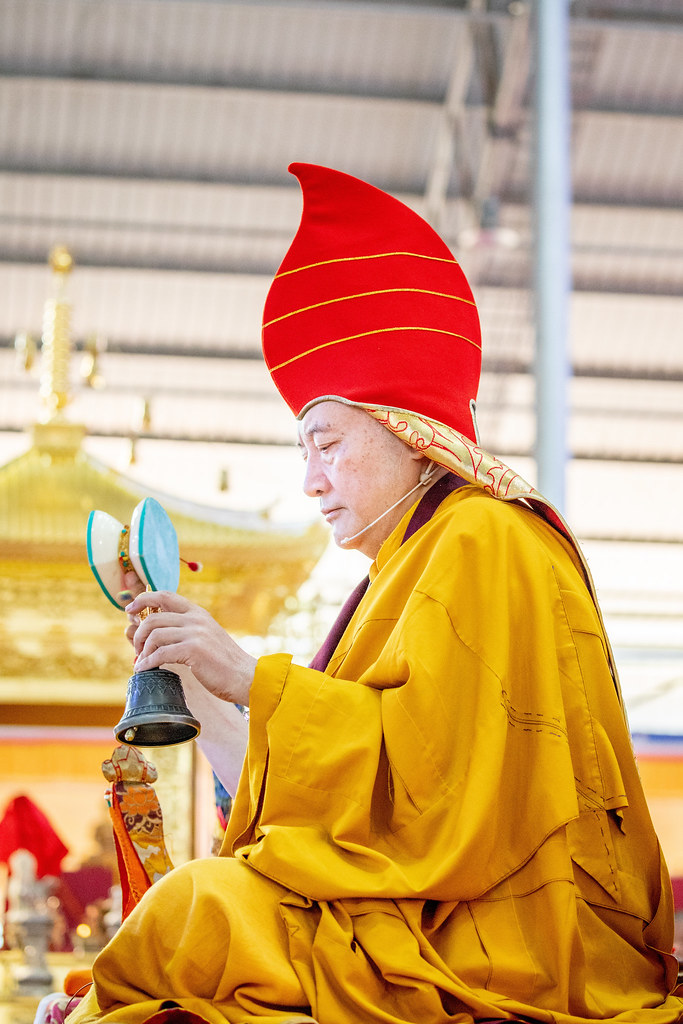
Monlam Pavillion, Bodhgaya
13 January, 2019
His Eminence the Goshir Gyaltsapa bestowed the Torma Empowerment of Gyalwa Gyatso to an assembly of international Sangha and Himalayan laypeople, who filled the massive vaulted pavilion to overflowing, spreading outside like a river to the pop-up stalls and hubbub of Indian street life.
The mandala, contained within an exotic glittering gold pagoda, came to life as the Goshir Gyaltsapa narrated the glorious history of Gyalwa Gyatso.
As was the command of the Gyalwa Karmapa during this event of pre-Monlam, I will give the 5 deity empowerment of Gyalwa Gyamtso. All of our practice of the dharma in the Himalayan region is related to generating the mind of awakening so we should think we receive this empowerment for the benefit of all sentient beings who fill the whole of space.
Gyalwa Gyamtso or the red Chenresig is one of three main yidams of the Karma Kagyu along with Chakrasamvara and Vajra Yogini. Many who have practised it attained siddhi and it has been of benefit to a great many beings.
There are many different lineages of Gyalwa Gyatso, some coming from India and later schools in Tibet. There were many texts of the practice of Chenresig but amongst them all, the one that has had vast benefit is this practice of Gyalwa Gyatso. There are different configurations of the deity; sometimes there are nine but in this particular practice there are 5 deities. Lamas, buddhas, bodhisattvas, heroes, dakinis, protectors, are all represented, so it is said there is no Buddha, bodhisattvas, hero, dakini, or protector that is not contained within this practice; including all the treasure texts of Chenresig that Guru Rinpoche hid in Tibet.
Gyalwa Gyatso is in the middle; the five deities are Hayagriva to the right, Tsomo Yeshe, a form of Vajra Varahi to the left, above is Padmasambhava, below are dakinis and protectors. Each of them is surrounded by a vast retinue of their kind. This practice is unique in that Gyalwa Gyatso’s retinue is an ocean of all the yidams, in Hayagriva are all the heroes, in Tsomo Yeshe all the dakinis are contained, around Padmasambhava is an ocean of siddhas and with Bernakchen below is the ocean of protectors.
History of the Lineage
Marpa brought back many teachings from India to Tibet but some of the secret mantra were left behind. He said to his disciple Milarepa, if it was possible to go to Tibet, he should go himself but if it was not possible, he should send one of his students. And so Milarepa sent his disciple Rechungpa to India, who attended a great many masters, but most special was the teaching of Gyalwa Gyatso that he received from the female mahasiddha, Machik Drupe Gyalmo. He also received another version of the practice from Tipupa. At this point the history becomes multi-dimensional. Tipupa was the consciousness transference of Marpa’s son Dharma Doday who died tragically in a horse riding accident. Marpa was able to transfer Dharma Doday’s consciousness to a pigeon who flew to India and transferred its consciousness into that of a dying Brahmin boy. So Rechungpa brought back to Tibet this practice from Tipupa, to the delight of Milarepa.
Rechungpa transmitted the practice to one of his students, his attendant, Zangri Repa, a ngagpa. Zangri Repa passed it to Dropa Repa, another ngagpa. When Dropa Repa travelled to Tibet at the age of 37, he took ordination and became one of the great siddhas of the Karma Kagyu lineage. His two principle students were Lodro Gyaltsen and Pomdrakpa, who attained siddhi. Pomdrakpa became the guru of Karma Pakshi who received many teachings from him, including Gyalwa Gyatso.
Karma Pakshi became a renowned mahasiddha through this practice, seeing the deity face- to-face. From that time, he became inseparable from Gyalwa Gyatso. When he met the Mongolian kings Kublai Khan and Gushri Khan, he showed miracles such that they became Buddhists. Through their influence, they spread the Buddhadharma and their benefit to beings was as vast as the sky. Karma Pakshi’s main student passed the lineage to Rangjung Dorje and then it continued through the line of Karmapas. Many great masters of Karma Kagyu have taken Gyalwa Gyatso as their yidam, including Karma Chagme Rinpoche, Jamgon Kongtrol Lodro Thaye; and many of the Karmapas, Shamarpas, Gyaltsapas, and Pawo Rinpoches.
Rinpoche led us through the meditation in which the five tormas represent the five deities of Gyalwa Gyatso.
He then conferred the torma empowerment individually on everyone present, as the monk and nun umzes led a continuous recitation of the ‘Twenty-One Praises of Tara’. Accompanied by Drupon Dechen Rinpoche and Shelri Tulku, Gyaltsap Rinpoche walked up and down the rows of monks, nuns and laypeople, placing the torma on the crown of their heads, before venturing outside to confer the empowerment on the hundreds who were waiting patiently in the approach to the pavilion. There were approximately 9000 people present and it took two hours.


































